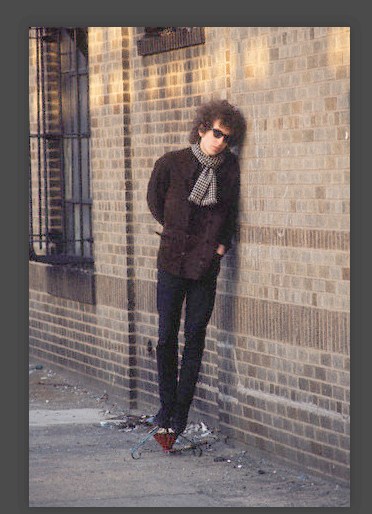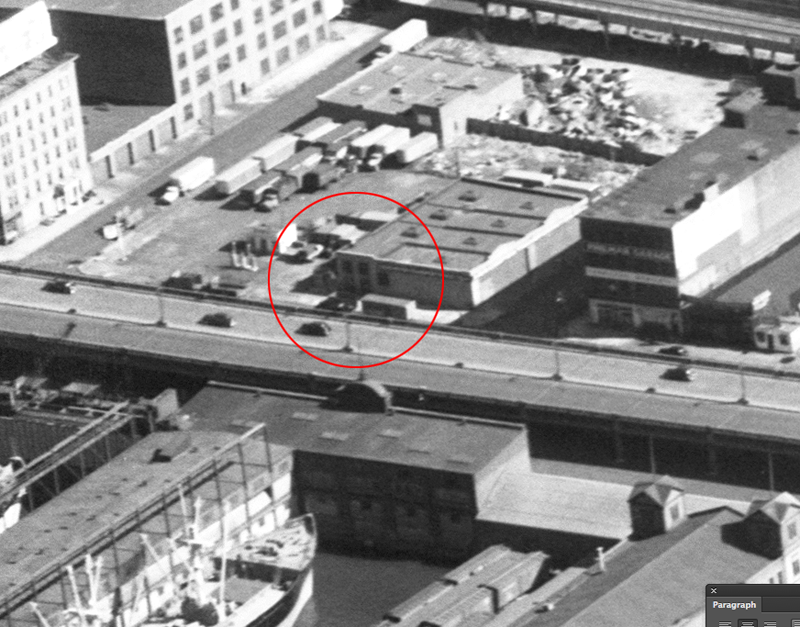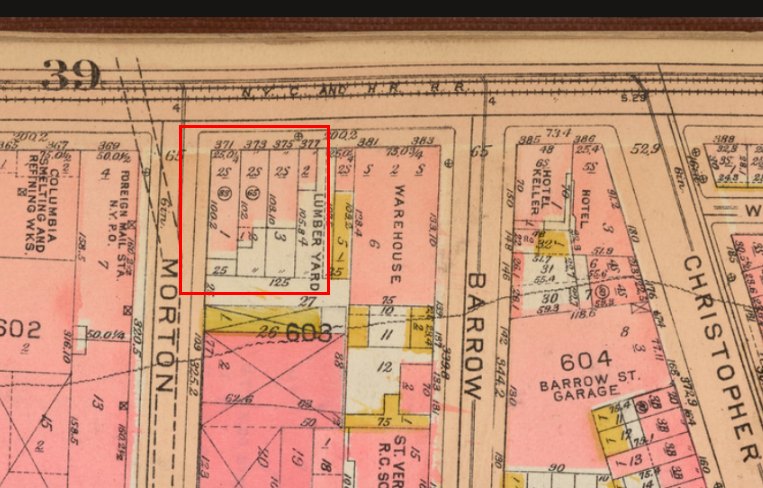 | |||
 | |||

|
Bob Dylan's BLONDE ON BLONDE (1966) cover photo by Jerry Schatzberg. Special Thanks (PopSpots gives special thanks to Bill Jobson, PopSpots reader and contributor, and photo sleuth for finding the 2 aerial photos that solved the riddle of the location of the cover shoot of Blonde on Blonde. You'll see his pictures below. Thanks also to Marie Fotini, Chief European corespondent for PopSpots and Jim Egan, author and historian, for their extensive research over the last few years in looking for the location. Thanks, too, to Jerry Schatzberg, the album cover's photographer, for his interest and for showing me the original slides for any clues. And a final thank you to other readers who have sent in thoughts and ideas about the cover over the years.)
Here's a picture of the the album cover. Before I show you the location, I'd like to give a few picture of background information to put the location photo in context. 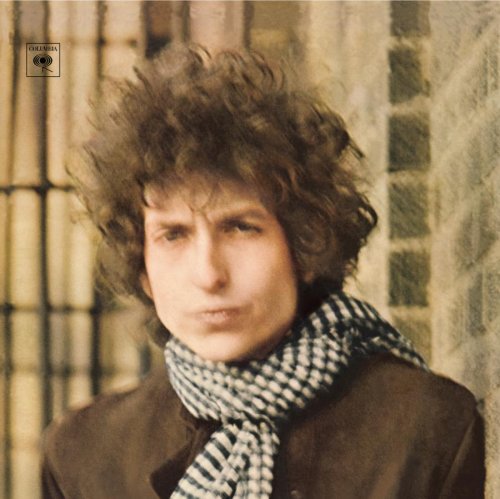
(Photo by Jerry Schatzberg; album cover courtesy of Sony Music) Here's the album cover, when opened, and turned 90 degrees. Blonde on Blonde, released in June of 1966, was rock's first double album, with Frank Zappa's double album Freak Out! released one week later. The album cover design was by John Berg. Unlike most albums, the name of the album and Dylan's name are not on the front or back cover; they are only printed on the "spine." The Colombia Records logo is the only "writing" on the front or back cover.) 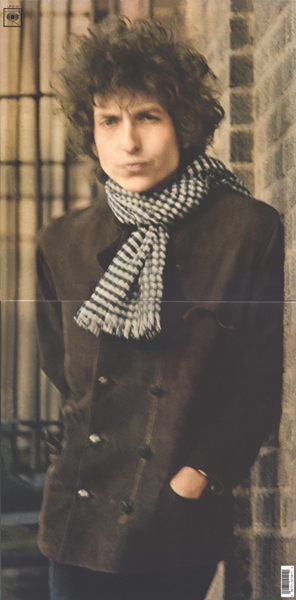
(Photo by Jerry Schatzberg; album cover courtesy of Sony Music) There are about 13 known outtakes from the session. Here are three that give a feel for the background: a multicolored brick wall, and a series of large windows protected by thick iron gates. On this particular shot, Dylan is standing on a Christmas tree stand. The air vent hole just beyond Dylan's right knee would be an important piece in confirming the location.
(Photo by Jerry Schatzberg) Here's a shot from a low angle. In most of the outtakes Dylan has an unlit cigarette cupped in his right hand. The clear sky in the background indicated that this was a low building and not surrounded by skyscrapers. 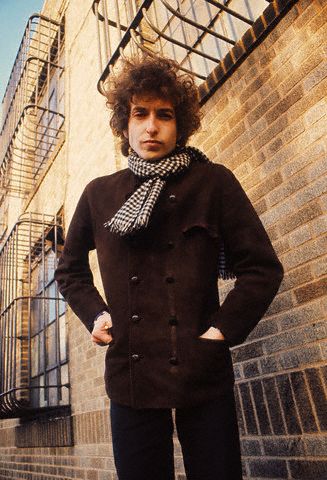
(Photo by Jerry Schatzberg) In this shot, Dylan is smiling. This picture, like the eventual cover shot, is blurry. Jerry Schatzberg said that on the freezing cold day of the shoot, they just jumped out of the car along the street and took a series of shots. By the end, they were shivering, and thus the blurry image. 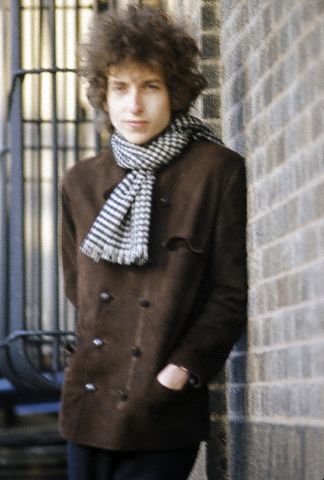
(Photo by Jerry Schatzberg) In order to try to visualize what the the building might have looked like, I lengthened the brick wall next to Dylan using Photoshop. When you see the actual location, you'll see that I wasn't far off. (Except that I was about 50 years too late. The building was taken down sometime between 1966 and 1976 and replaced by an apartment house.) 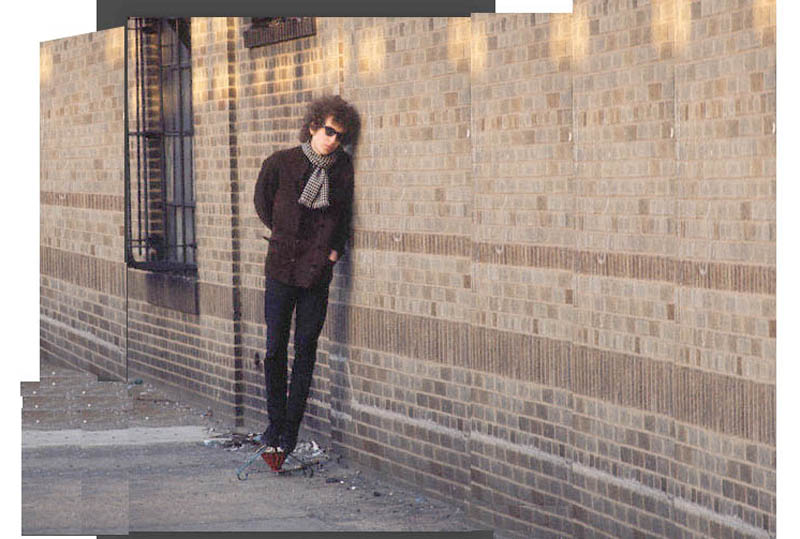
(Composite based on a photo by Jerry Schatzberg) I also made a composite showing three of the iron window grates. In reality, there ended up being two more grates behind the last two you see. 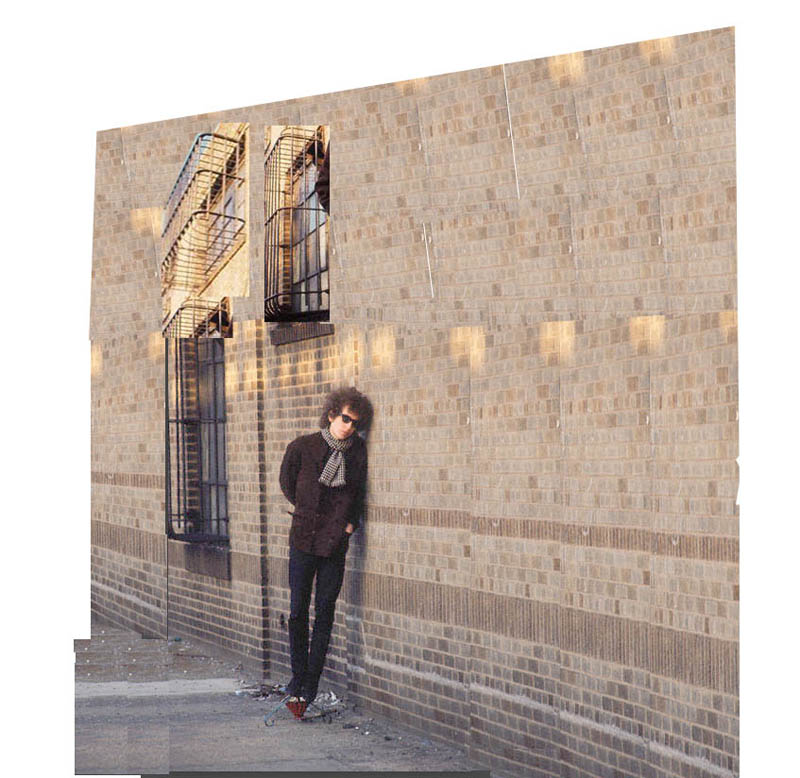
(Composite based on a photo by Jerry Schatzberg) I'll discuss more about the search later, but first I want to set the scene for the location: Jerry Schatzberg said he had no particular destination as a background on the day of the shoot and it's easy to see how they could end up along West Street (now the West Side Highway) while looking for late afternoon sunlight. We're not sure if they all left together from Jerry's studio, or whether he picked up Dylan along the way. 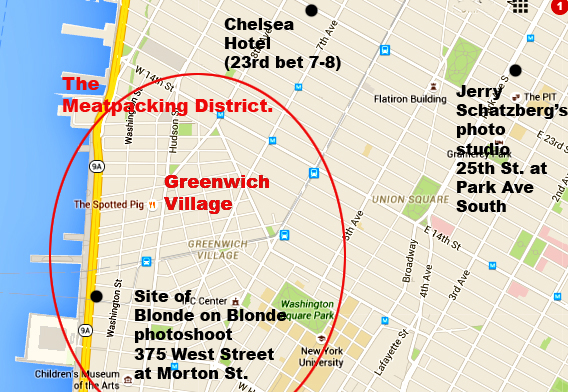
Here it is. Here's the location of the Blonde on Blonde photoshoot. 375 West Street at the northeast corner of Morton Street, Greenwich Village, New York. (The building is #371 West St. , but the lot is #375 West St.. See note below photo for more.) Dylan is standing next to the middle window grate, looking south. You can see how easy it would have been for Schatzberg and Dylan to pull off to the sidewalk, jump out and snap off a few shots. 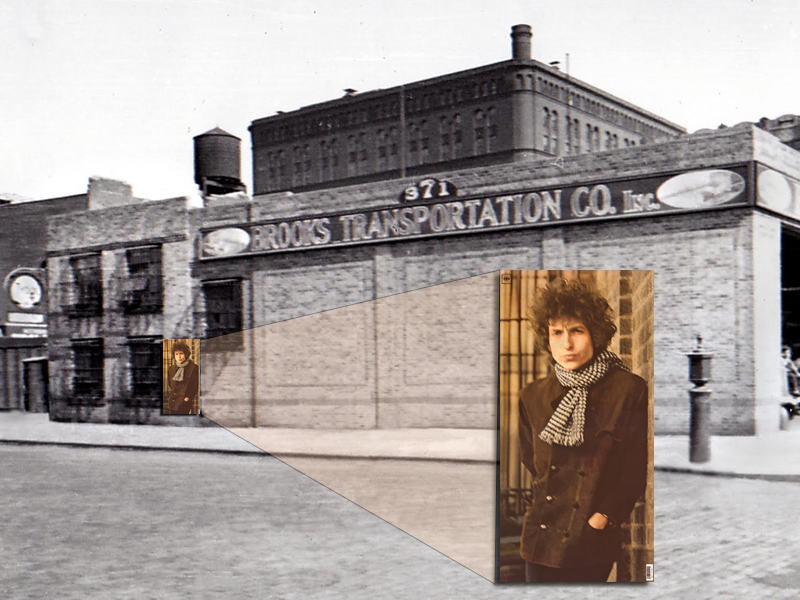
(Source: NYC Municipal Archives; Photo of Dylan by Jerry Schatzberg; album cover courtesy of Sony Music) (Note regarding #375: The Brooks Transportation building's street number is #371 West Street, as we see in the picture, but the building takes up three 25-foot wide lots which were #371, #373, and #375 (see the insurance map further down in the entry). Dylan is standing in front of the middle of the lot which was #375 West Street, which means he's about 60 feet in from the corner of Morton.) (2nd note: The alternative address of the Brooks Transportation Company was #117 Morton Street, as you will see later in a photo from a 1940's phone book.) At the time there was an elevated highway (the West Side Highway) along West Street. It was dismantled in 1989. "West Street" is mostly a local name. Nowadays people refer to this as part of the West Side highway. This black and white photo would have been taken from under the elevated West Side Highway. That is a cleaned-up version of this version - made from the unedited photo that came from the New York City Municipal Archives. The number in the front means Block 603, Lot 1, Manhattan. It's from a collection of every building in New York City taken by the Archives between 1939 and 1941. The Brooks Transportation Company building has been demolished, replaced by apartment buildings. The three large buildings in the background are still standing. 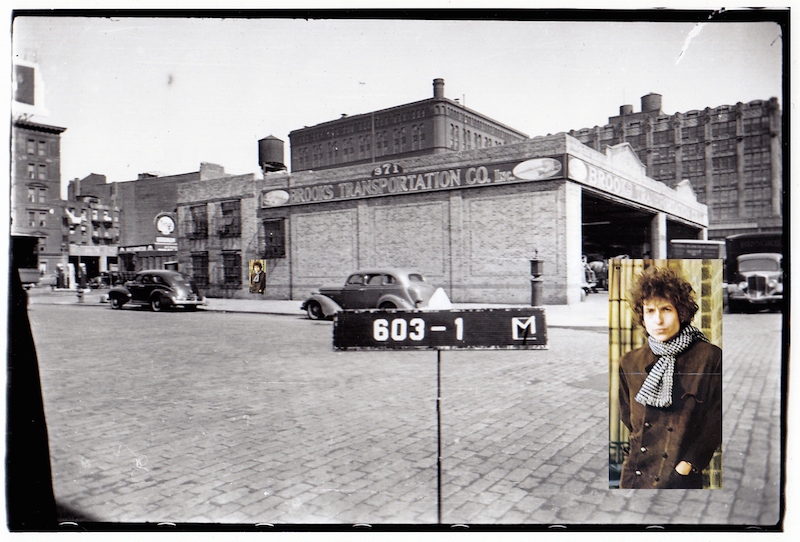
(Source: NYC Municipal Archives; Photo of Dylan by Jerry Schatzberg; album cover courtesy of Sony Music) Here's a more realistic-sized version with nice Photoshopping by Bill Jobson. 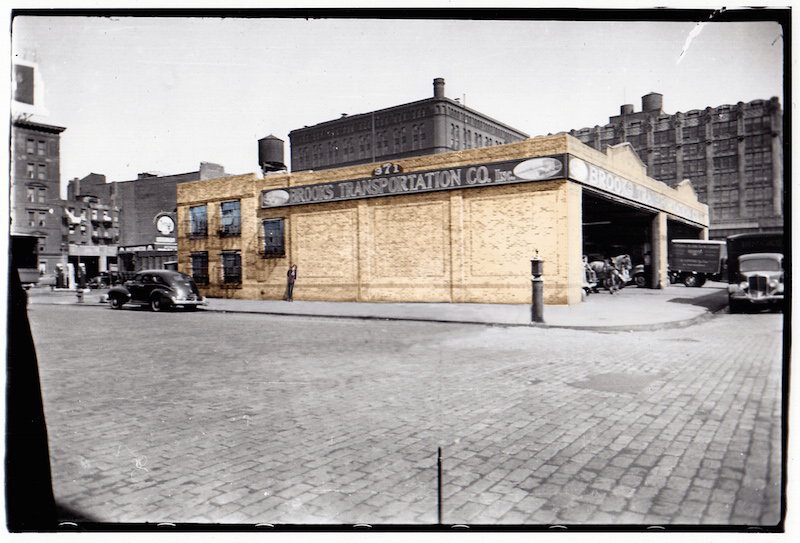
(Photo of Dylan by Jerry Schatzberg) During the Dylan photoshoot, the late afternoon sun was low over the river, casting a shadow over Dylan in some pictures, as seen in the next photo. Here we see Dylan in shadow, and the light above him is light coming through the railings along long the west Side highway. 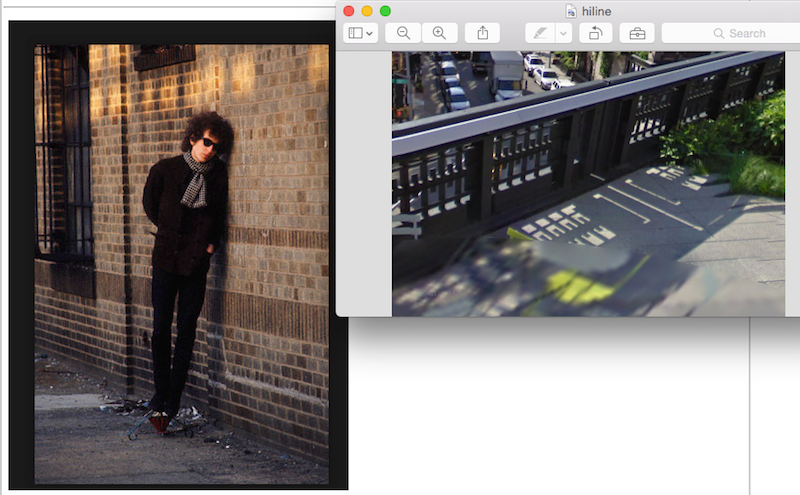
(Photo by Jerry Schatzberg) Here are some other versions showing the Blonde on Blonde location. For this one, we took out the old cars from 1939; so that this was basically the exact scene as when the photo was taken in 1966. #1 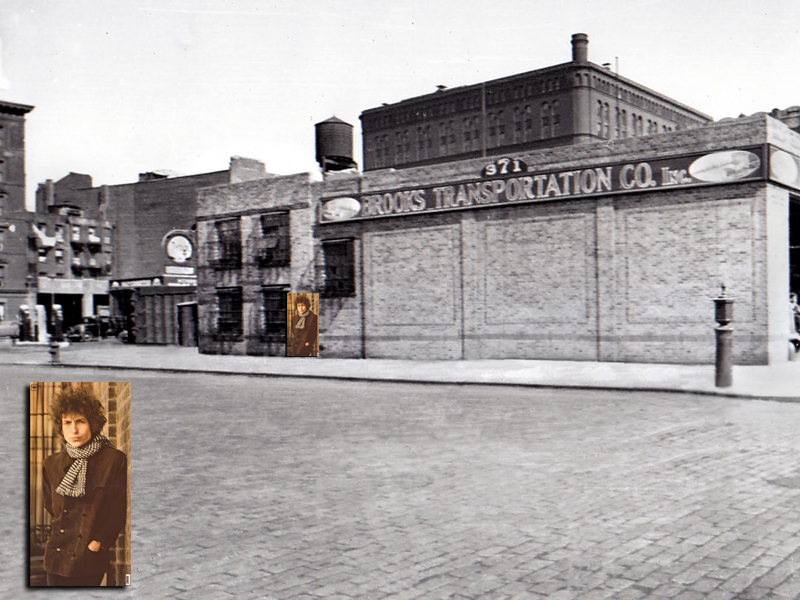
(Source: NYC Municipal Archives; Photo of Dylan by Jerry Schatzberg; album cover courtesy of Sony Music) #2 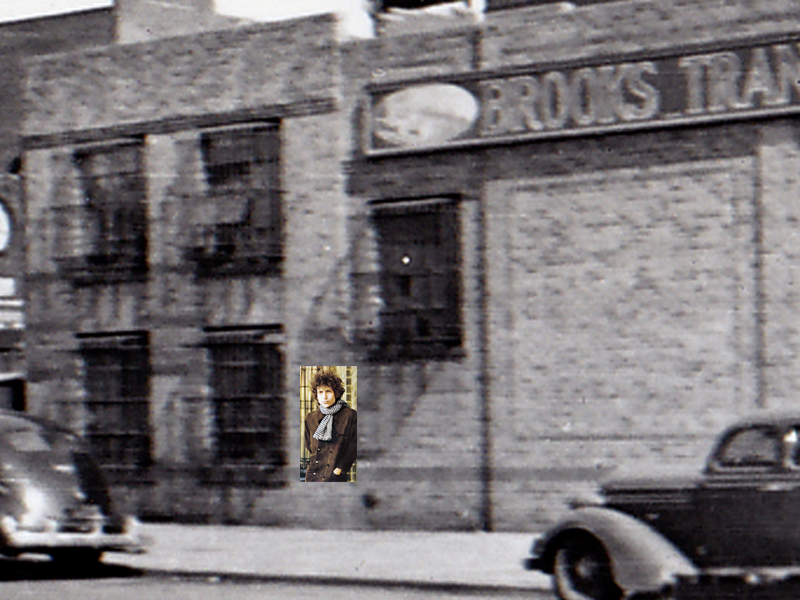
(Photo of Dylan by Jerry Schatzberg; album cover courtesy of Sony Music) #3 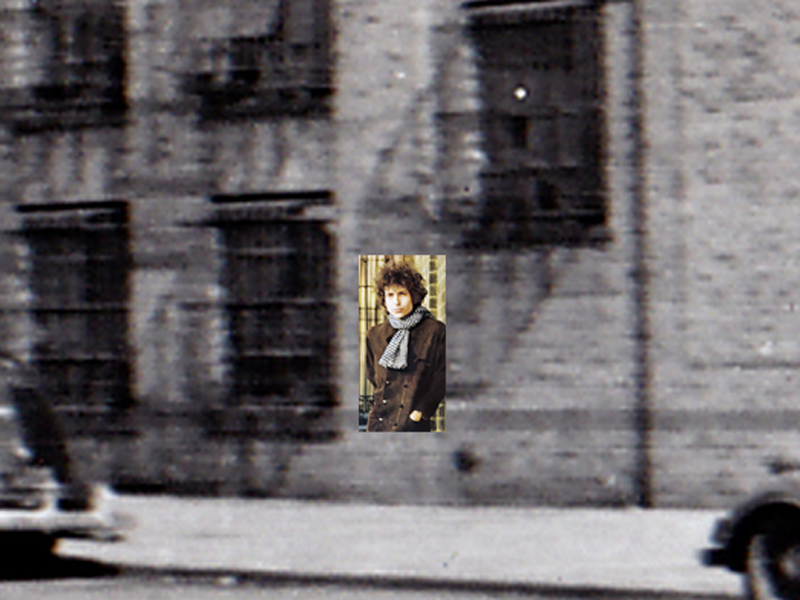
(Photo of Dylan by Jerry Schatzberg; album cover courtesy of Sony Music) #4 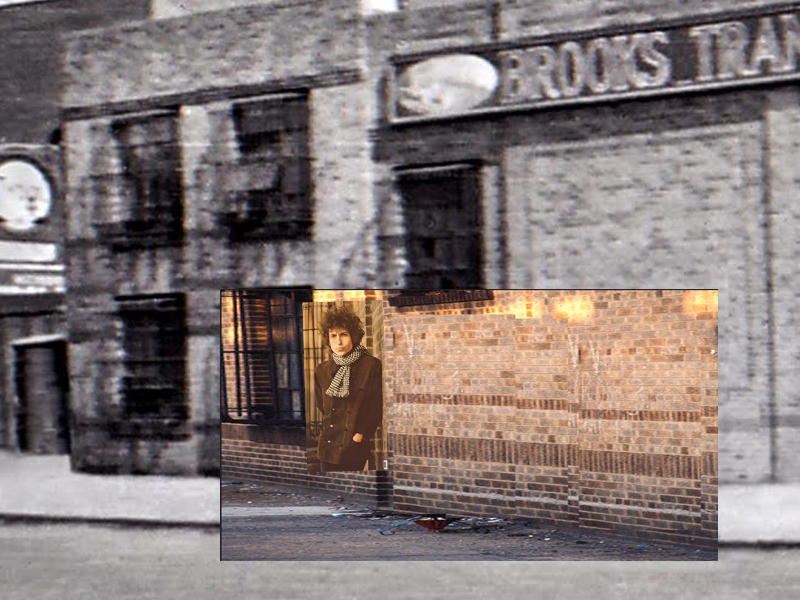
(Photo of Dylan by Jerry Schatzberg; album cover courtesy of Sony Music) #5 (A rough mock-up pushing my Photoshop retouching skills to the extreme. Hopefully, in the future, we will find a color shot of the wall.) 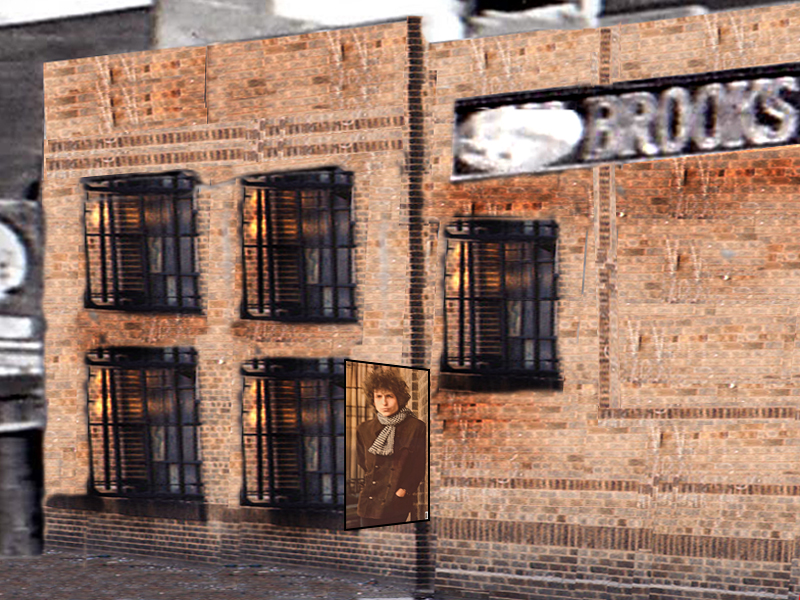
(Photo of Dylan by Jerry Schatzberg; album cover courtesy of Sony Music) This is one of the apartment buildings that has replaced the garage Dylan was standing next to. It's located at the northeast corner of West Street and Morton Street. It's one of a series of about a dozen buildings buildings taking up the whole block, part of a group of buildings called the West Village Houses. It was built between 1966 and 1974 with the input of the famous urbanist Jane Jacobs. 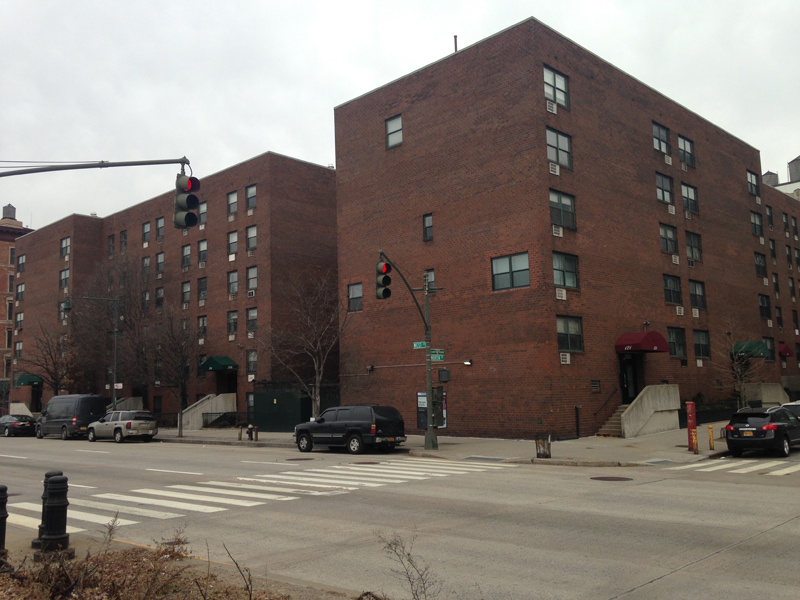
With this photo (below) you can see where the garage would have been in relation to the modern day buildings. The three buildings in the background are still there. On the far left is the 6-story Hotel Keller, shut, but landmarked. The big building in the back is the now called The Archive Building (666 Greenwich Street at Christopher) and has apartments. Monica Lewinsky lived there once. And the large building on the back right, 95 Morton Street, is a full-block office building.
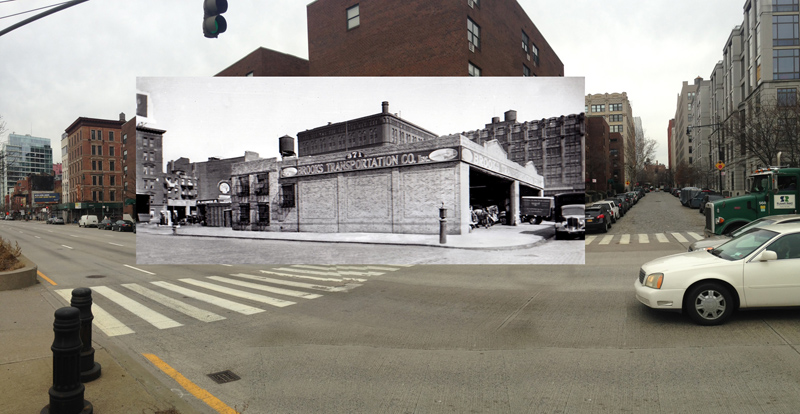
And here's one showing where Dylan would have been, about 60 feet in from the corner, starting at a line extending from the edge of the concrete steps. 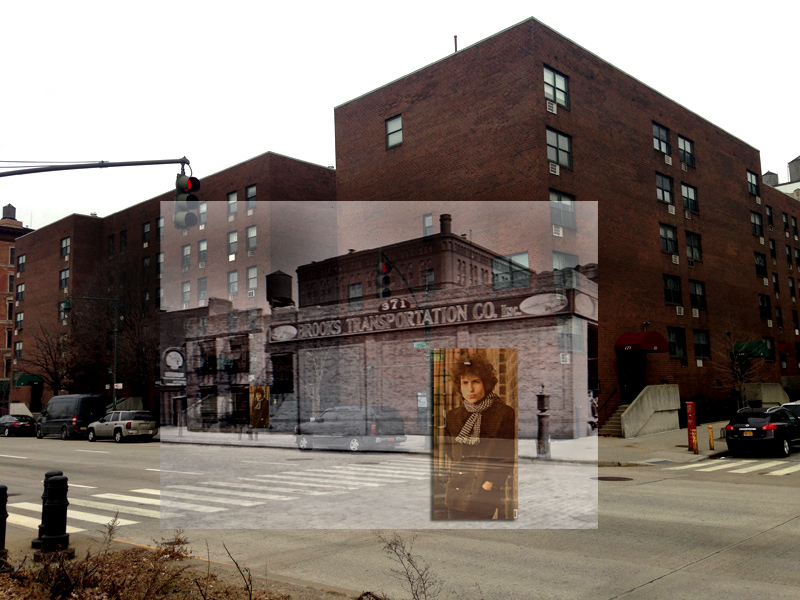
Now let's back up a moment and take a look at how we ended up at this location. I have been looking for the Blonde on Blonde site since the birth of PopSpots about 5 years ago. In fact, I started PopSpots after I brought Blonde on Blonde into several used record stores near Bleecker Street and asked them if they knew where the photo was taken. No one, to my astonishment, knew. I had figured than someone would have run across the location in the last 50 years and mentioned it while discussing Dylan records. So that search led me to build a web page showing where album covers were taken, so visitors to New York (and other cities) could experience the location themselves, and here we are, about 200 covers later. And all along, the cover of Blonde on Blonde has been the Holy Grail of my searches, always in the back of my mind as I wandered through the streets of downtown NewYork while looking for other PopSpots. In my search for Blonde on Blonde, I originally thought it was this building in the Meatpacking District, but it was not to be. In an early PopSpot, based on Jerry Schatzberg's having been quoted as saying he took the photo on the west side of Manhattan (which made sense from the late afternoon sun in the photo), I made about the cover of Highway 61 Revisited, I made a map of where I thought Blonde on Blonde might have been taken. It basically stretched from 42nd Street down to a place called Washington Market, where the Freedom Tower is now. And over the years I would look at brickwork of buildings that looked like the Blonde on Blonde brickwork. . .. . . .and iron grates all over the city - even in back of buildings. I made a contraption to test the reflective rays of the afternoon off of building windows. 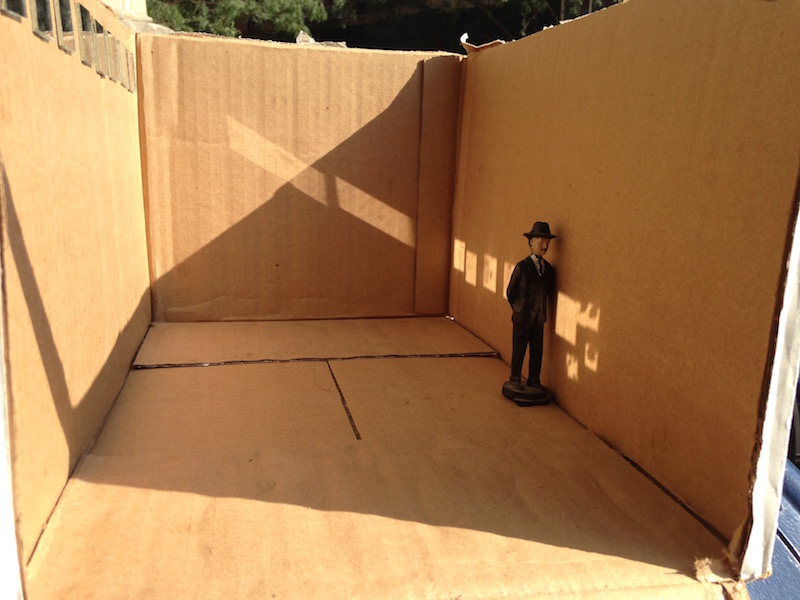
And, just in case, the westside was not the place, looked around where Jacob Street used to be, near the Brooklyn Bridge, which was the scene of Jerry Schatzberg's photoshoot for the large picture of Dylan wearing a white scarf inside the album fold, a search covered in PopSpots #5. 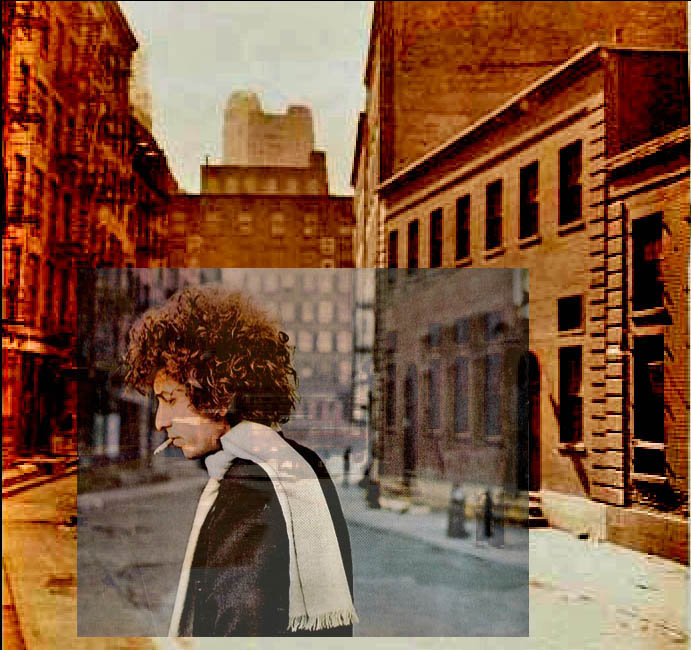
(Photo of Dylan by Jerry Schatzberg; background photo NYPL Digital Archives) Here's a picture of the inside of the album showing the white scarf photoshoot. (By the way, Jerry told me later that that he took the picture of Dylan on the left side, bottom right, on the way to the Saturday Evening Post cover photoshoot.) 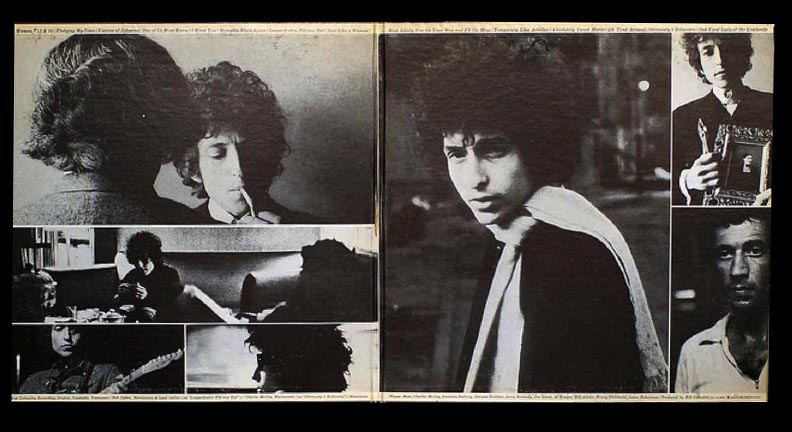
(Photos by Jerry Schatzberg; album cover courtesy of Sony Music) The coolest part of the search was when I was asked by Columbia Records to walk around New York's meatpacking district with Jerry Schatzberg himself, in a promotion video for Bob Dylan's series of box sets for the "Cutting Edge" collection, and see if it might help Jerry remember exactly where he took those thirteen pictures 50 years ago." We didn't find he spot that day, but where Jerry thought he might have taken the photo was on the same side of the street, one block over, and in the same general neighborhood where he had actually taken it. So, pretty close. (To see the video, click here. 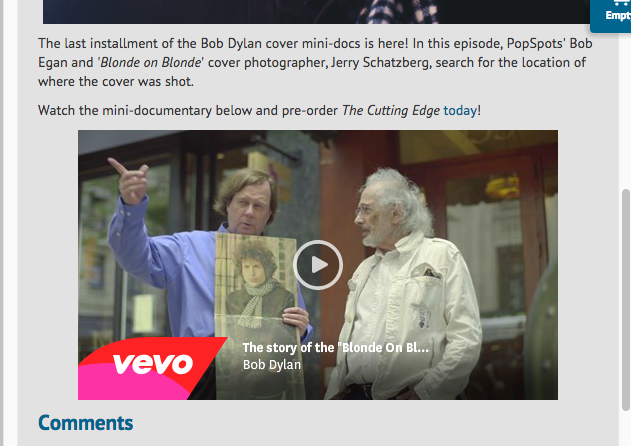
So I had moved on to other searches when recently Bill Jobson, a graphic designer for a downtown New York media company, who previously had sent PopSpots a Dylan-related photo he had found, sent me a photo of the West Side highway near Christopher Street (below). The photo showed that there were "see-thru" decorative walls along the highway (see the circle). Did I think they could have created the unusual lighting pattern over Dylan in the Blonde on Blonde outtakes? Well, yes, I did and, when asked, I suggested he might focus his search between Canal Street and 42nd Street, where it was most likely the photo was taken. I told him I had walked there and not found anything, but he might find something that I hadn't, though a lot of buildings there had been knocked down. 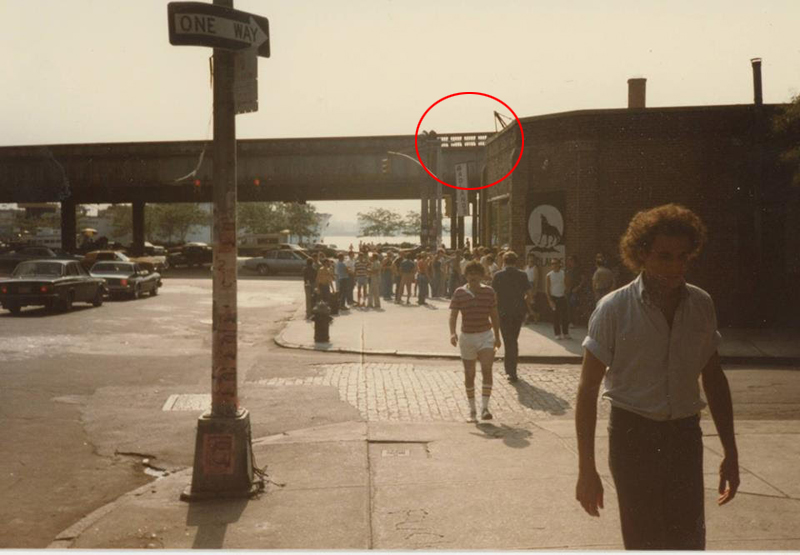
Then, about a week later he sent me the 2 pictures that he had found through a database of photos a New York State website, adding "I think I found something very interesting." Here's the first picture. Notice what's in the circle. 5 windows grates, with the far right one in the middle. It was just like in the outtakes from Blonde on Blonde!
(Photo: New York State Archives) Here's the other shot he sent. Same building. Different angle. He mentioned that they were at the corner of West Street at Morton Street. 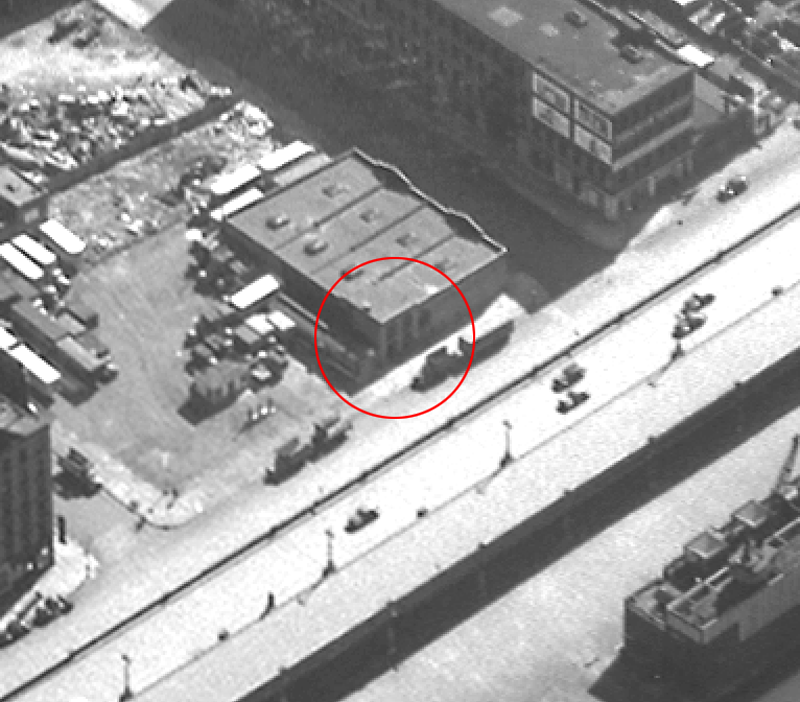
(Photo: New York State Archives) I immediately wrote Bill and said that I think he had "found the unfindable." But I would need a lot of confirmation before I could be 100% sure that this was the site. I'd get back to him after I checked the NYPL digital files for a closer, street level photo. I called up the New York Public Library site called "OldNYC.org" where you can search for old photos by street corner. 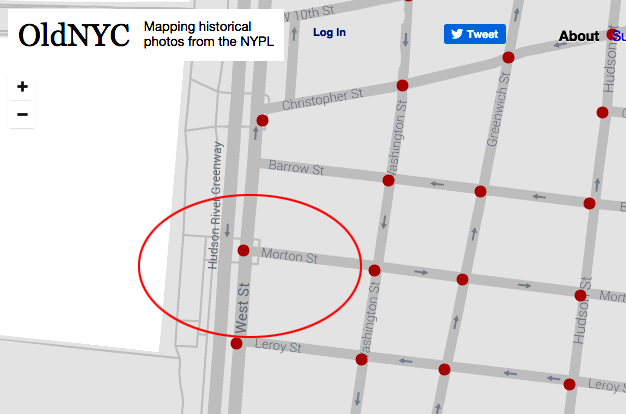
Clicking on the red dot at Morton and West Streets, among other pictures, I retrieved this: 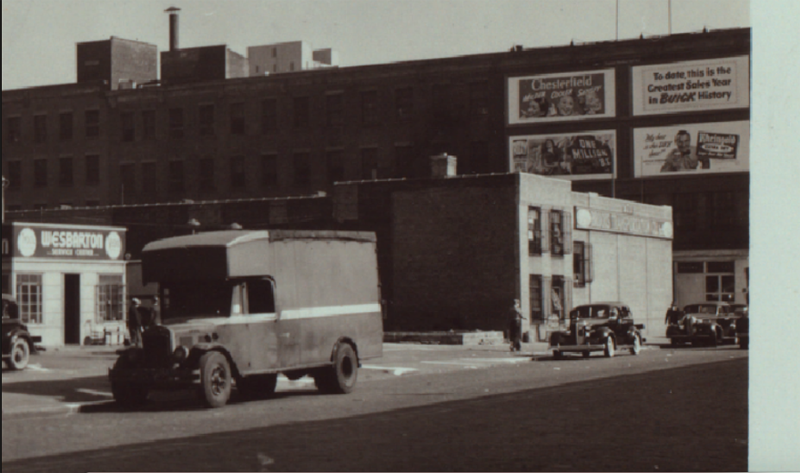
(Photo: NYPL Digital Archives - Image ID 724701F) I zoomed in. That looked so close to what I thought the Blonde on Blonde location look like I could taste it. Whatever that means. But still, the grates looked a bit too large, and there looked like a deep inset gap between the quadrant of 4 grates and the single grate that was not in the outtake photos. (It turned out to be an optical illusion caused by an extra layer of bricks over the top grates.) 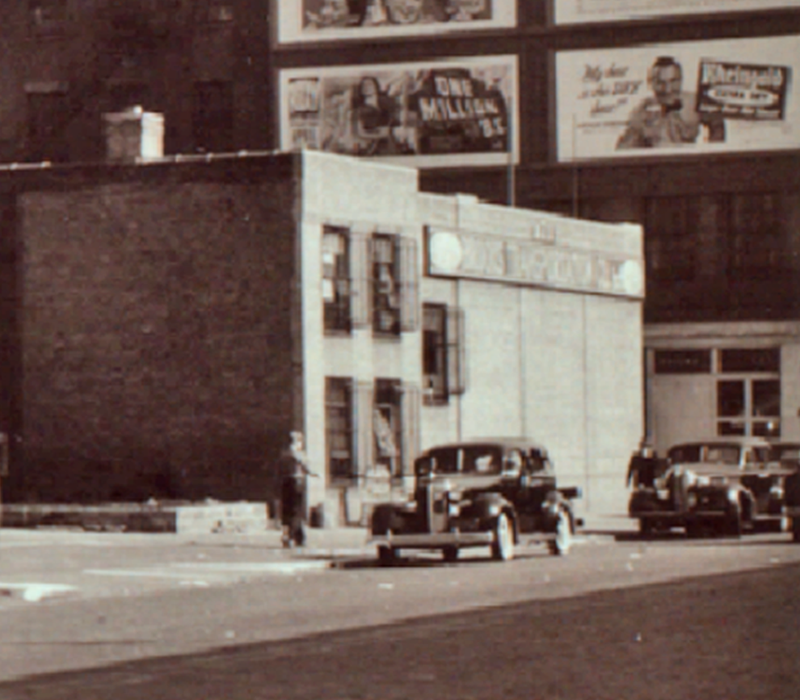
(Photo: NYPL Digital Archives - Image ID 724701F) So I sent it to Bill and he sent back another shot from the library site and this time there didn't seem to be any gap. 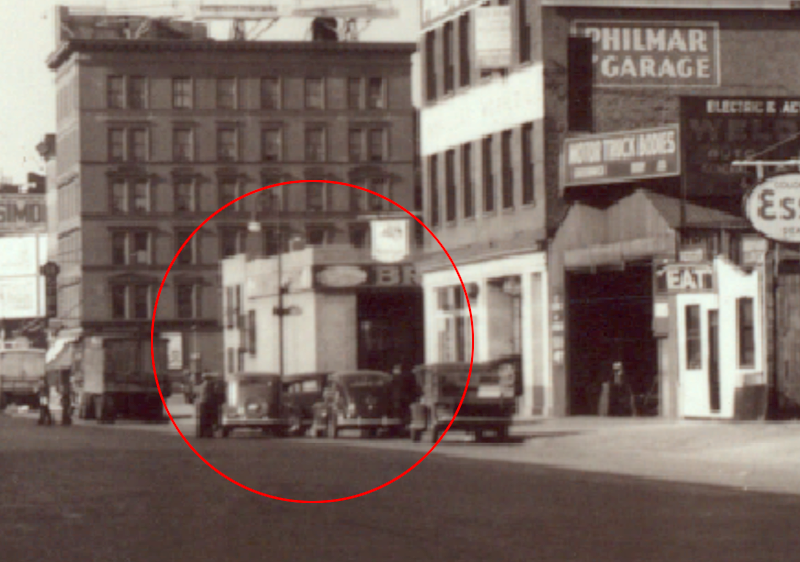
(Photo: NYPL Digital Archives) So there was really only one way to get to the bottom of the issue: get an original photo from the New York City Municipal Archives Office on Chambers Street. They have photos of every building in New York that they took in 1939-1941. Here's where they are located 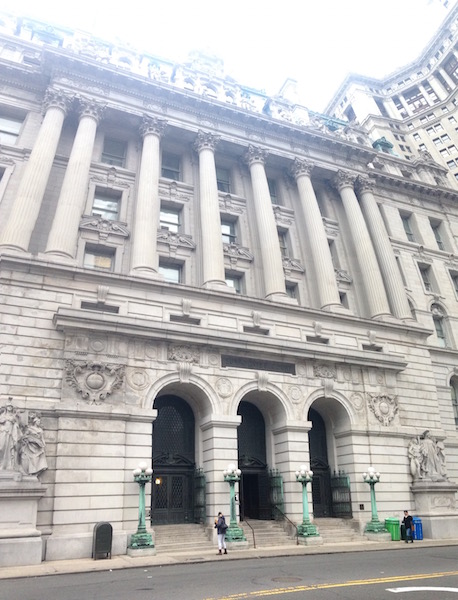
So, before going down the next day I found the block and lot out from this map I had obtained from the New York Public library. Dylan seems to be standing in front of #375 and #377 West Street, so the block and lot for that building was Block 603, Lots 1, 2,3, and 4. (Those lots are now just referred to as Lot 1.)
So I went to the archives and looked up the block and lot number. It told me that the photo would be on a particular roll of microfilm in section F-1588. 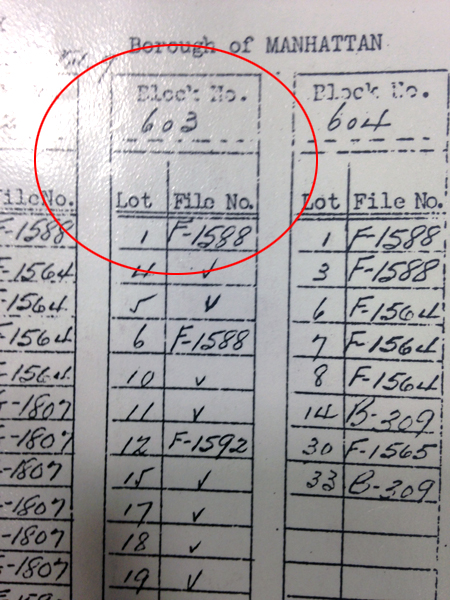
Here's what that revealed, in a photo taken off the computer screen. It sure looks like the Blonde on Blonde site to me, and even seem to have the horizontal row of dark bricks about two feet off the ground, as in the Dylan pics. 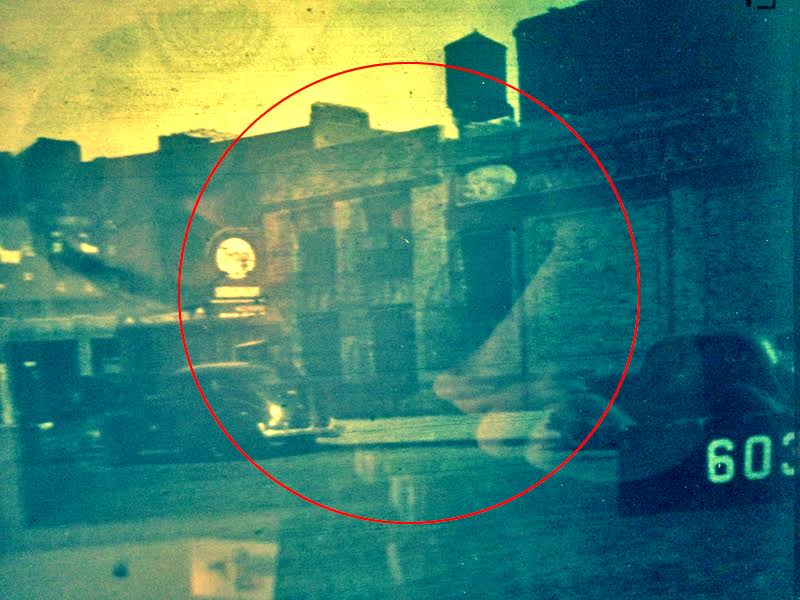
(Photo: NYC Municipal Archives) So I ordered a "rush job" 8 x 10 photo and, after what seemed like an eternity, picked it up 2 days later. I even took a photo of the envelope before I took the photo out, because I felt like I was opening an Academy Award envelope. Either the proof was in the photo and we won. Or, there was a huge problem and we lost. 
Fortunately, we won. I could tell the instant I looked at it. Here's the photo. 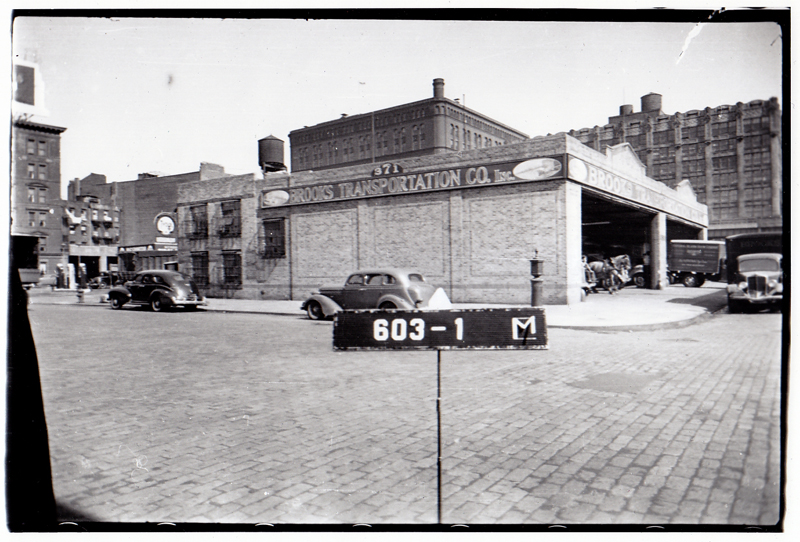
(Photo: NYC Municipal Archives) How could I tell? Behind Dylan's leg we had always notice an exhaust hole, like from a clothes dryer. The hole was in the exact same position on the new photo. Bingo! A 100% match! That hole, photographed in 1939, was still there when Dylan had his picture taken there in 1966. And it became the proof, in 2016, 50 years later, that this was where the picture was taken! Holes, we salute you! 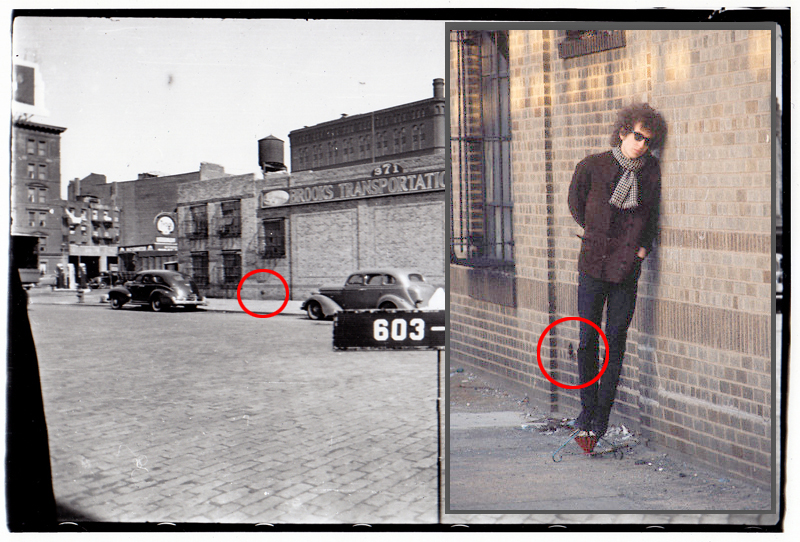
(Photo: NYC Municipal Archives; photo of Dylan by Jerry Schatzberg) We eventually checked out everything to make sure it matched up. Here, for example, are some of the architectural similarities which Marie, our French correspondent soon noticed. 
(Photo: NYC Municipal Archives; photo of Dylan by Jerry Schatzberg) We checked the Brooks Transportation Company in the 1940's NYC telephone directory (which can be found online). Turns out it went by several names. 
But for right now, coming out of the Archives, I emailed a smart-shot of the photo to Bill, Marie, and Jim - the team - and said we had a winner. I added that I was going over to West and Morton to photograph the site. As luck would have it, Bill said he was free and could meet me at the site. And we did! So here's Bill standing just about where Dylan had been standing in 1966. 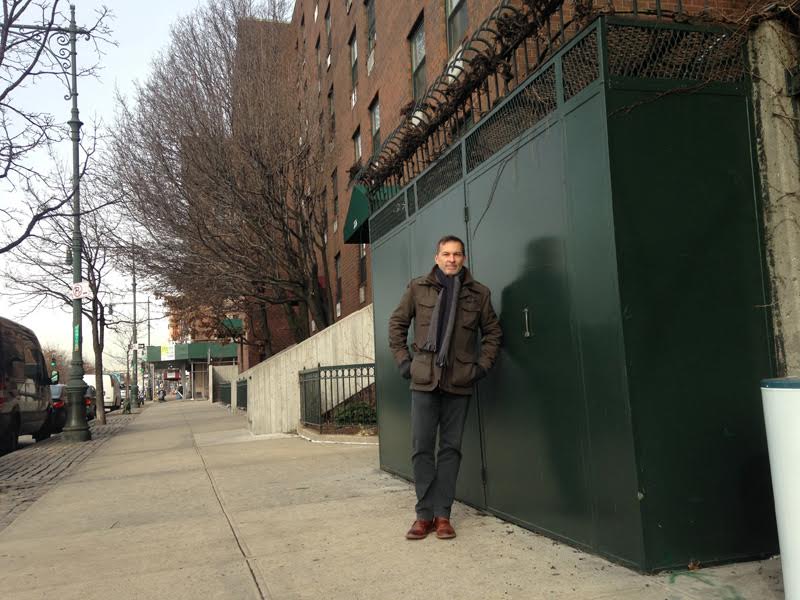
I'll show you what it looks like there now. First I matched up the Archives photo with the apartment building there now. (The address of that building, then and now, is 371 West Street.) 
I took a panoramic shot so you could see the whole block. Because the cars move during the pan, they look like alien droids from Star Wars. (Maybe they were!). 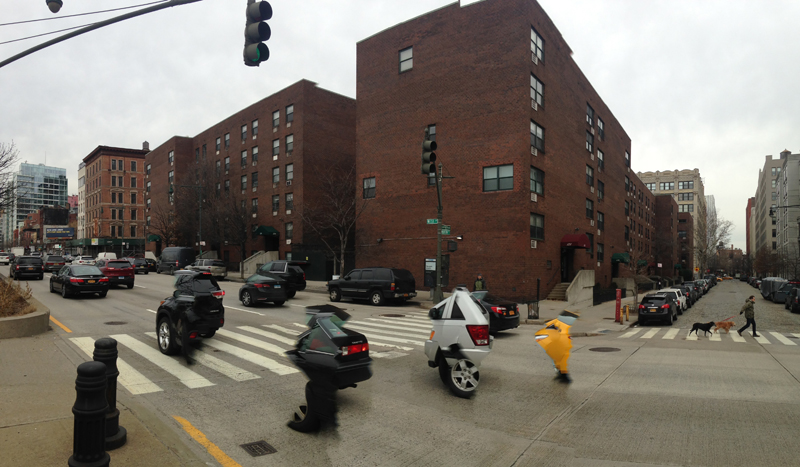
I also took a shot of the area where Dylan was standing, based on the old library insurance maps, which was about 60 feet north of Morton Street, next to where that green wooden structure along the sidewalk is now. 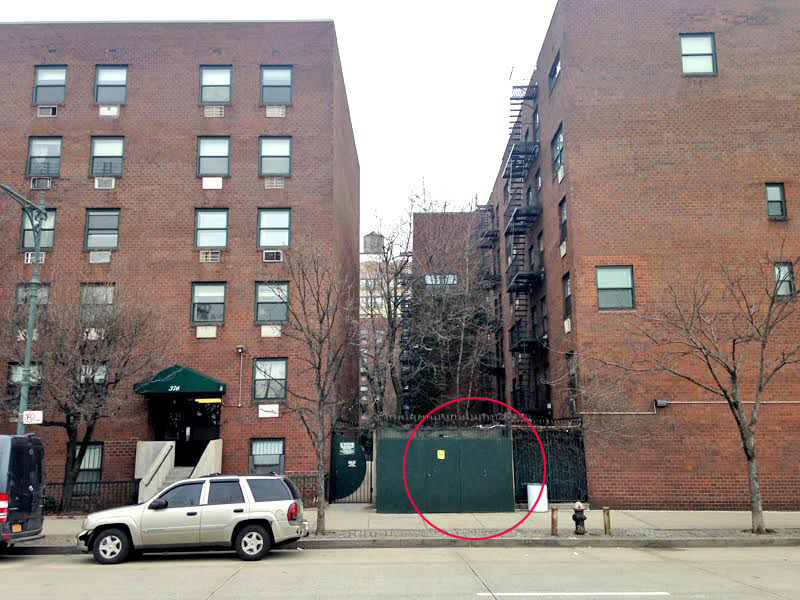
Then I spun the camera around. This is a picture looking south. That's the Freedom Tower in the background where the Twin Towers used to be. The area is still called the World Trade Center. 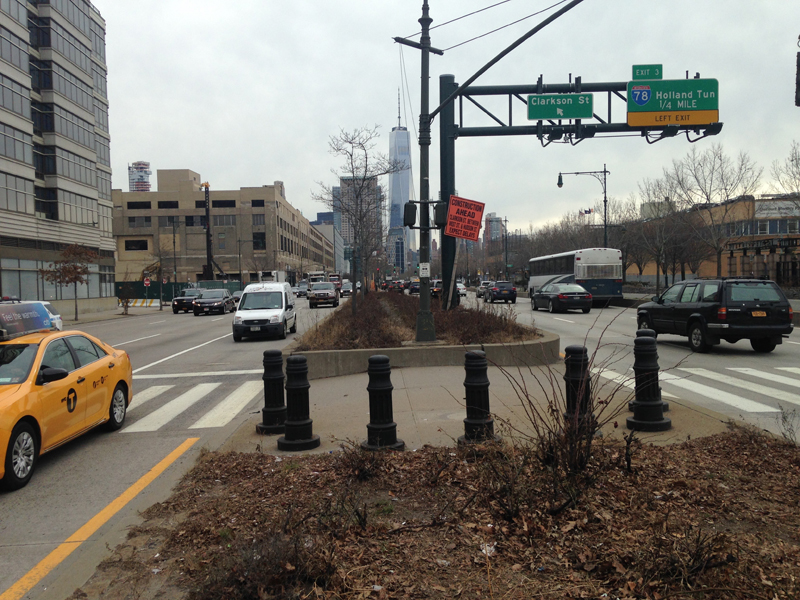
Spinning further, we now look west out over the Hudson River at Hoboken, New Jersey. 
Another twist has us looking north toward the Meatpacking District. To the right I've circled a sign on an old vacant hotel that is a link to the past. 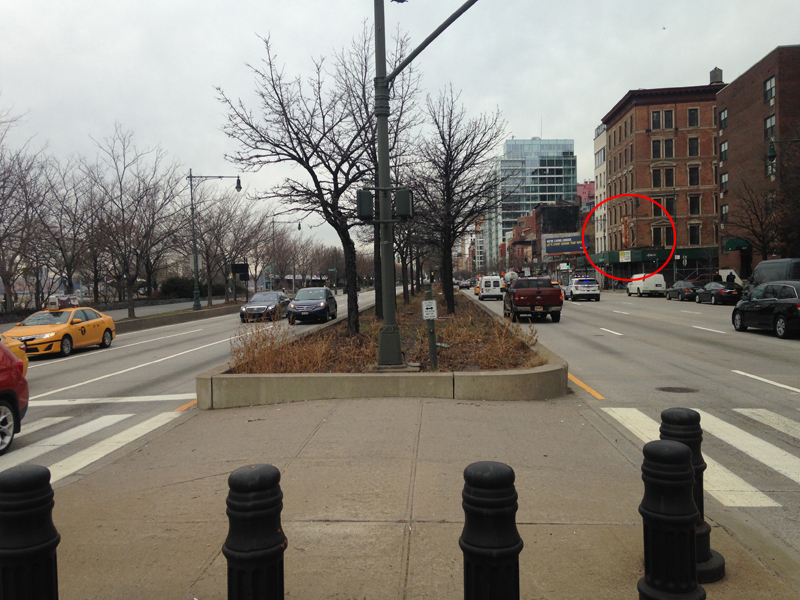
The building is called the Keller Hotel and is landmarked and awaiting development. But's it's kind of frozen in time to the era when Dylan was down the street being photographed. The red arrows point to a sliver of the building Dylan was photographed in front of. 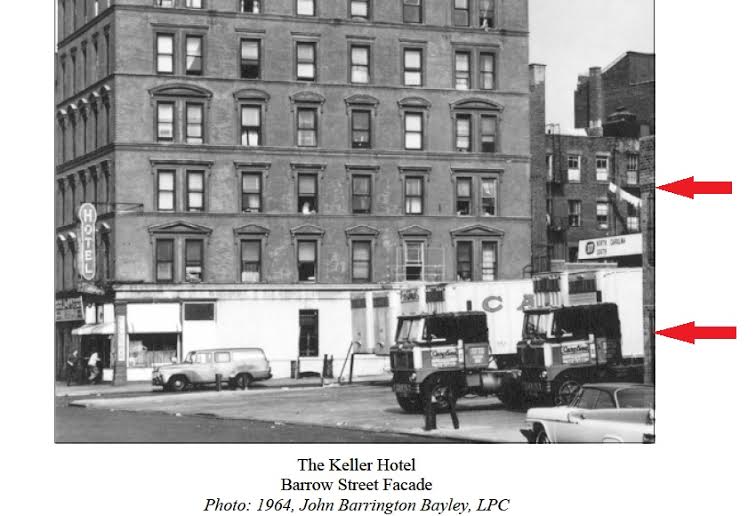
(Photo: Landmarks Preservation Commission) The sign is from a New York City of another era. 
I was standing on the ground, on an island in the middle of the West Side Highway taking those last shots I showed you. Back in Dylan's time, my location was more often called West Street, because there was an elevated highway over where I was standing, called The Elevated West Side Highway. You can see the highway on the cover of this book. You can also see the location of the Dylan photoshoot in relation to it . 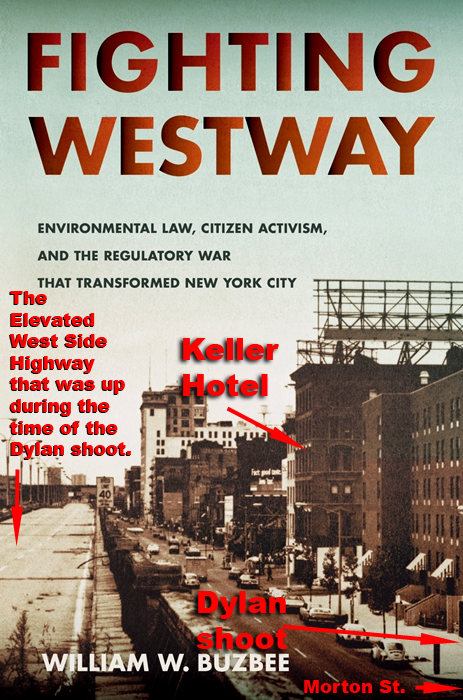
So that's the story of the photoshoot of Blonde on Blonde. I knew all along that one day, somehow, I would see a photo of the site of Blonde on Blonde. Having been searching photos for PopSpots for so long, I know that practically every street in this wild and crazy town has been photographed if not once, many times. You just have to dig. Thanks again for Bill Jobson for his digging. And thanks to Mr. Bob Dylan for being not only the inspiration, but also the background music during most of these searches. 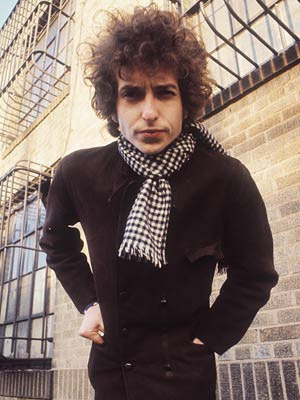
(Photo by Jerry Schatzberg) 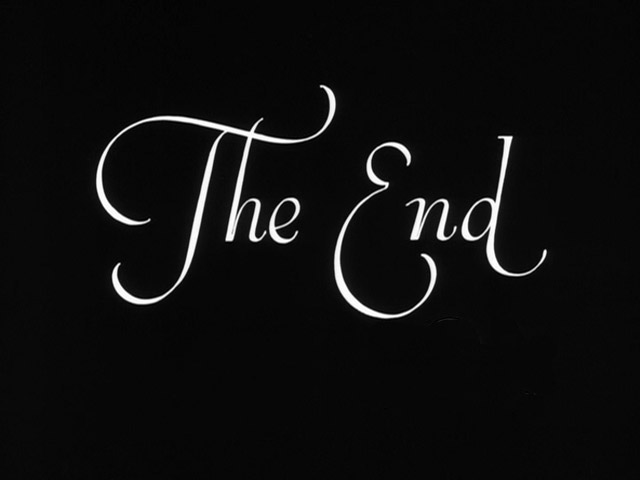
ADDENDUM: 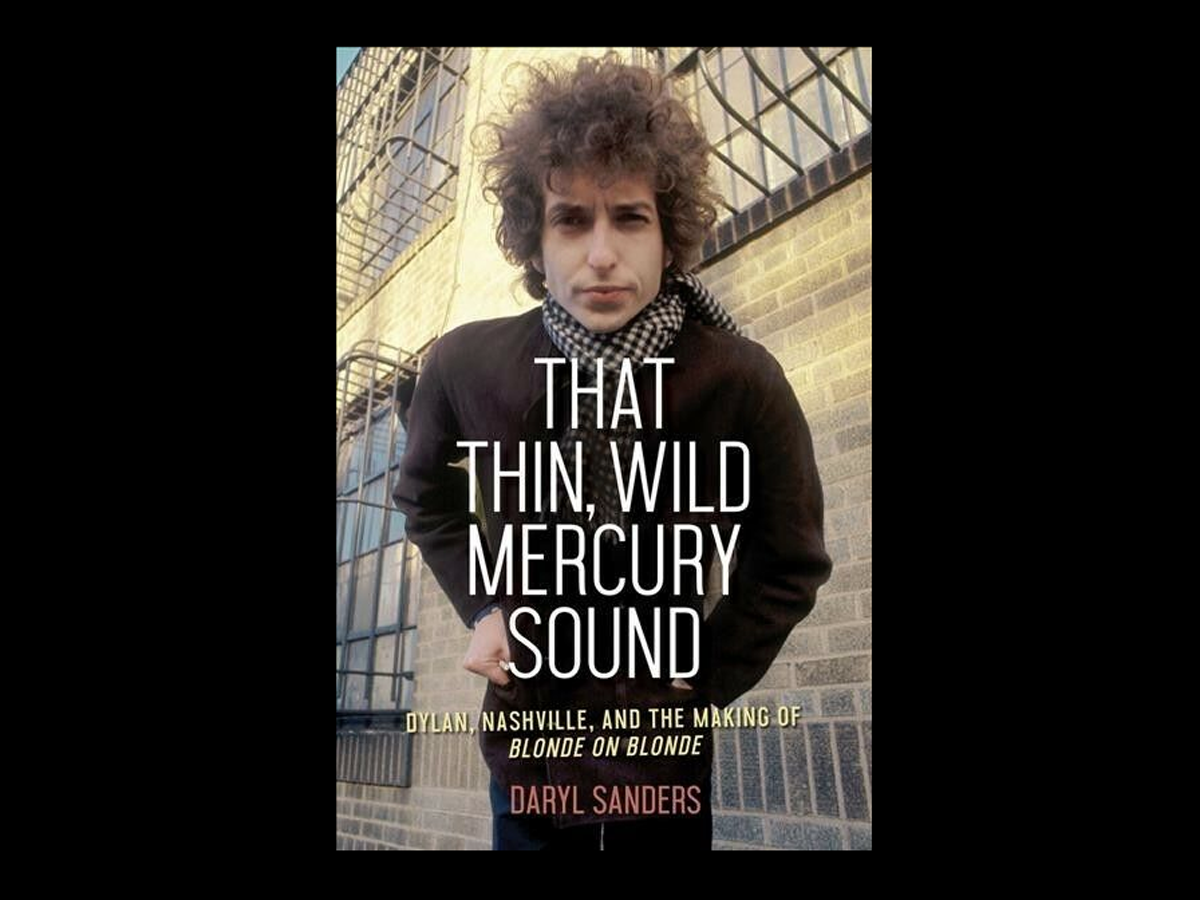
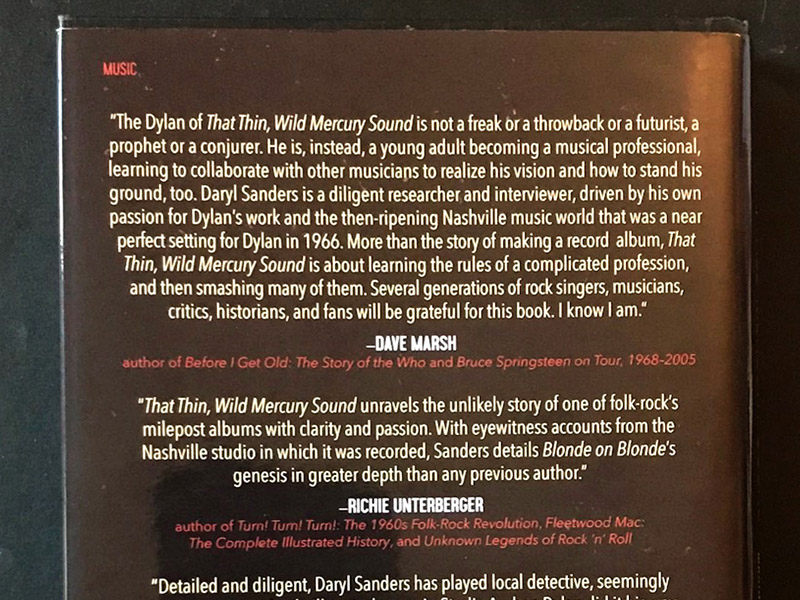
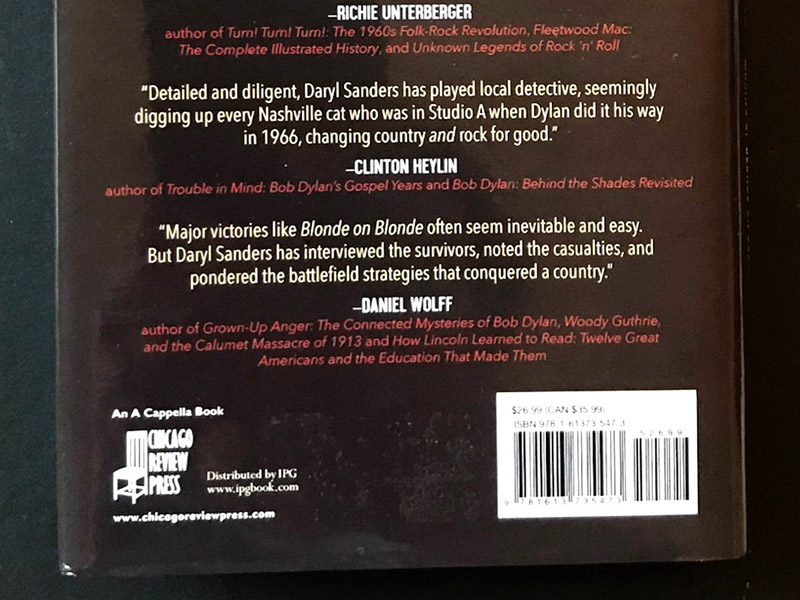
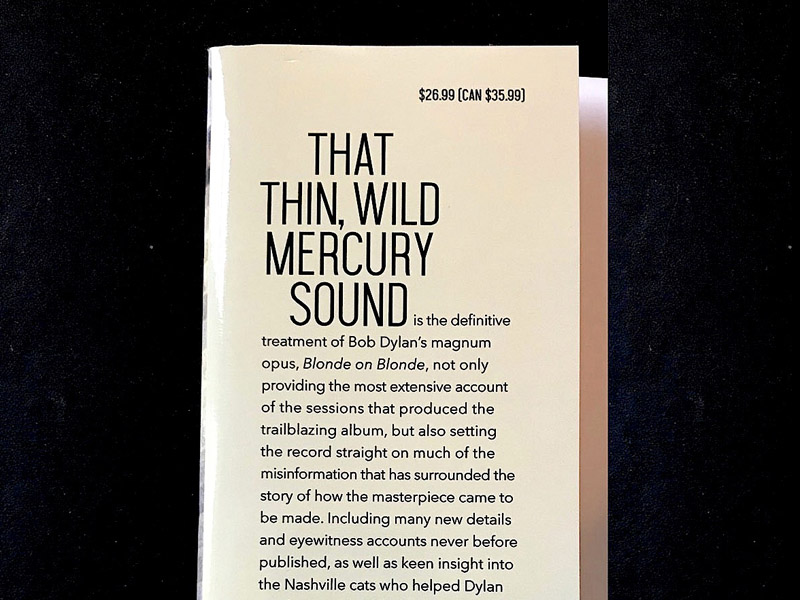
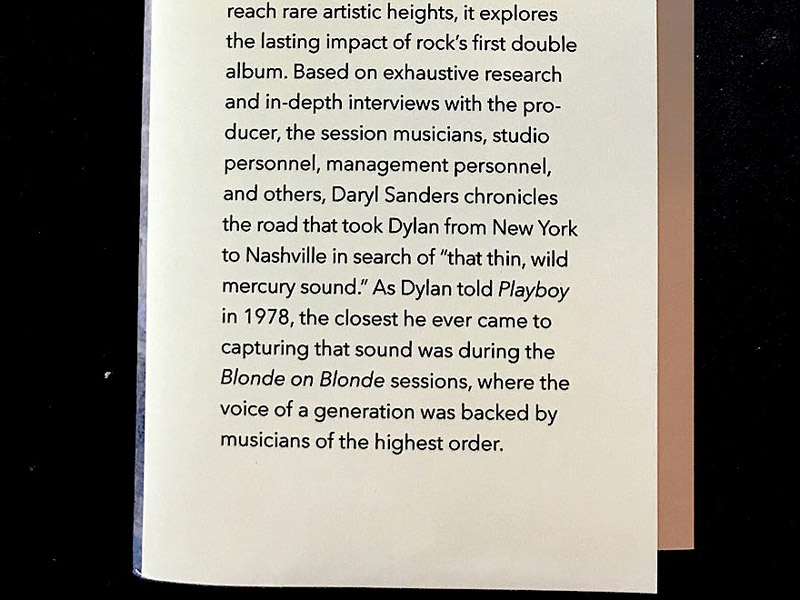
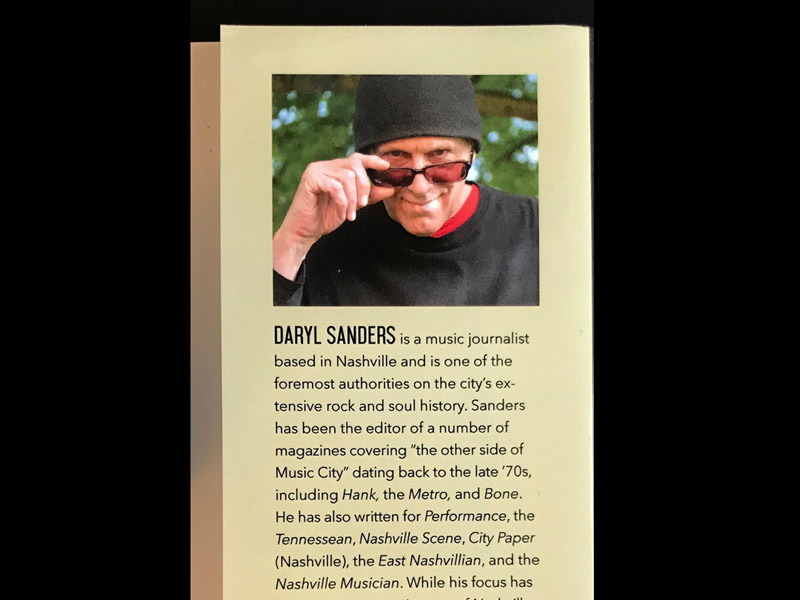
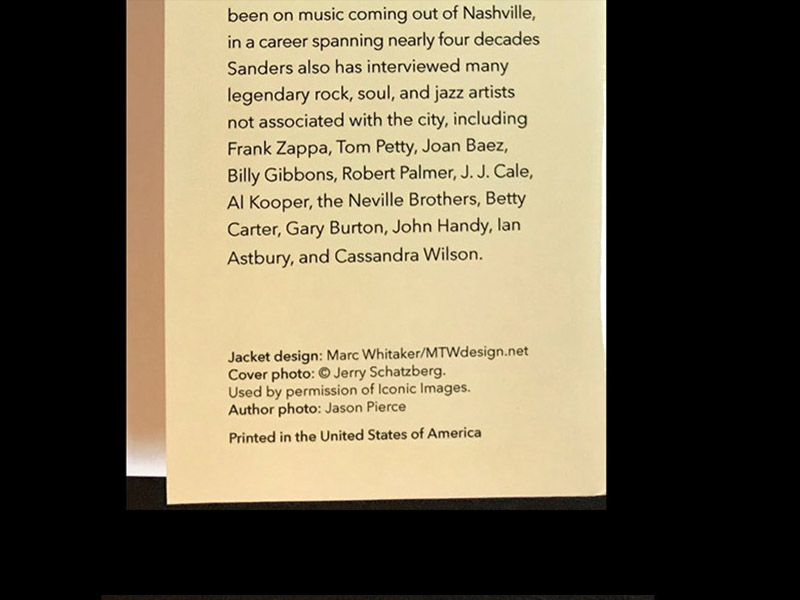
For an in-depth review of THAT THIN, WILD MERCURY SOUND from The East Nashvillian, click here, |
||

